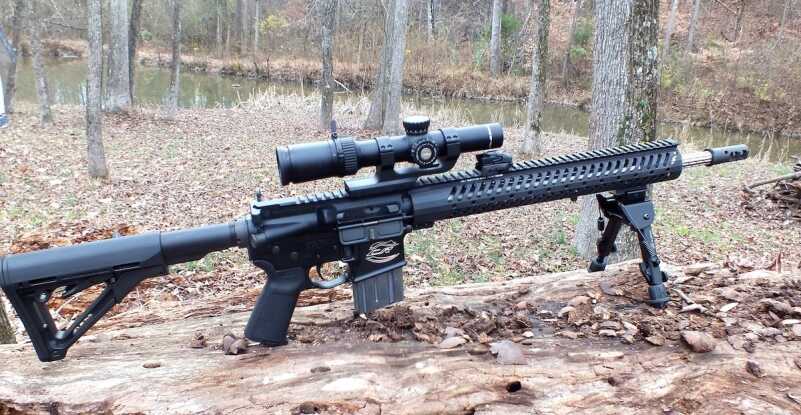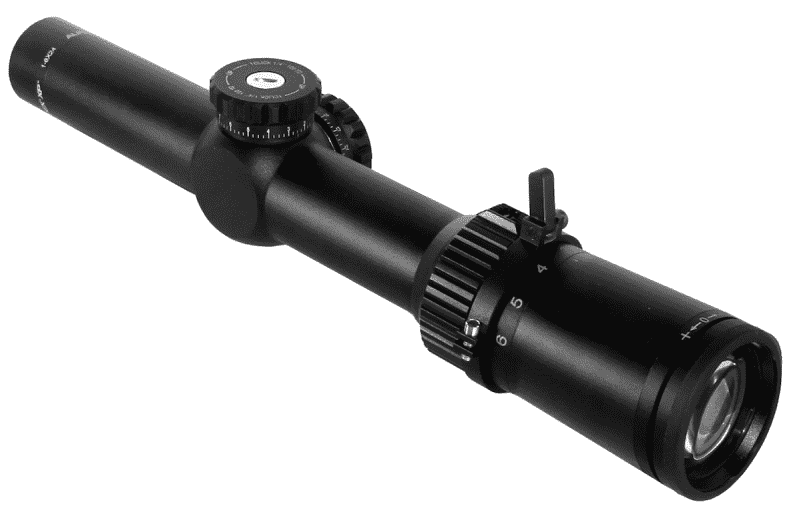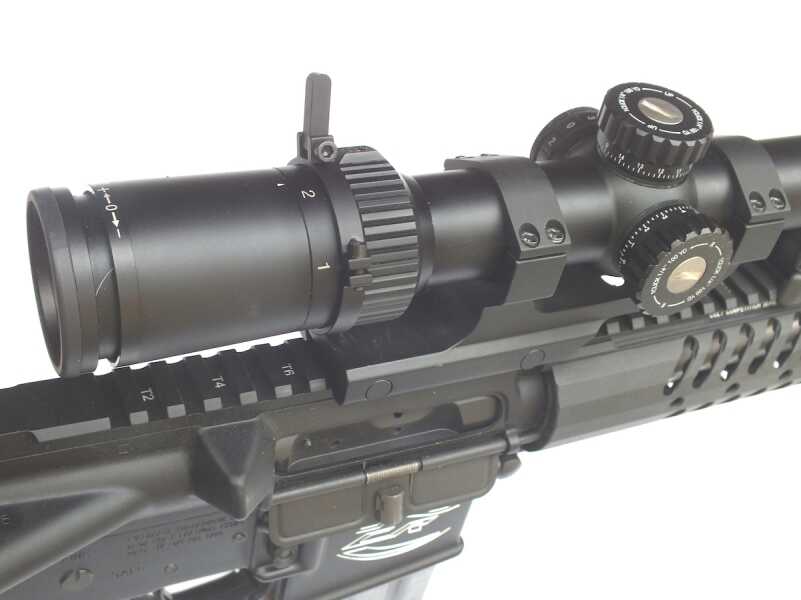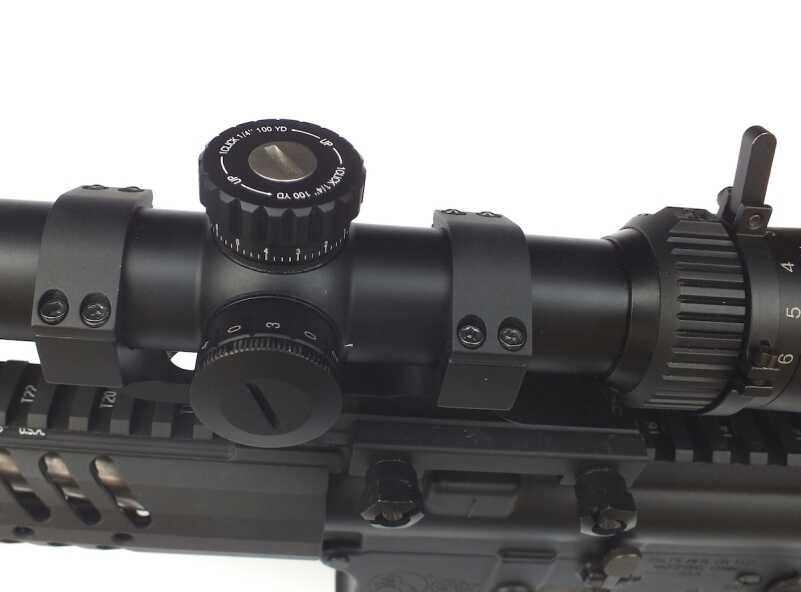
The Alpen’s Apex XP AR 1-6X24 scope complements an accurate carbine by providing both fast close quarter sighting at 1X with medium range magnification of 6X.
To learn more, visit https://www.alpenoptics.com/RScope-apex.html.
Sometimes I think there are as many opinions about the right choice of optic for AR platform rifles as there are AR platform rifles. Today, we have a remarkable number of viable optic choices for medium-range ARs. Traditional scopes are an easy choice for rifles that are built for extended ranges beyond a couple of hundred yards. It’s when we begin to think of short range, defensive use of the AR that the choices get tougher.
For extreme close range in good light, the standard M4 iron sights are pretty good. With the larger, ghost ring aperture flipped up, almost anyone can rapidly acquire a target fast and get good hits. In defense of those standard iron sights, a little training can provide real accuracy along with remarkable speed out to 200 yards and even beyond.
Reflex and holographic tube sights work well at close range but almost all require batteries or they’re dead. Most also reduce visibility in low light conditions, and they have no provision for allowing the shooter to keep the rifle level, a requirement when shooting at ranges long enough that holdover or additional elevation is required. Any time there’s substantial drop in trajectory, keeping the line of sight consistent with the bore is required because if the rifle is canted holdover will also affect windage.

The Alpen scope offer shooters a great mid- to short-range AR scope for not a lot of money. Image courtesy of the manufacturer.
The Answer?
To fully utilize the capabilities of a good AR-15 at both close and longer ranges, there’s no better optic than a low magnification variable. A 1-4X variable will provide enough magnification for reasonable shooting as far out as about 400 yards, and farther if the target is clearly defined by color or background. For standard AR-15 rifles this is a suitable arrangement, but for rifles that have good triggers, free-floating front tubes and match barrels, there’s enough accuracy to extend the effective range out to as much as 600 yards which is considered to be a medium range target in NRA High Power.

While the speed handle for most scopes is an expensive option, the XP AR comes with the speed handle already installed. It allows fast changeovers from close range shots to medium range capability out to as much as 600 yards.
There are some detractors of low-magnification variable scopes on close quarter carbines saying the size of the turrets and mount obscure the vision of the operator, but this simply isn’t true. Looking through a 1X scope, much less of your vision is obscured because you’re looking from a position halfway down the barrel. Through a 1X scope, most of the gun in front of you disappears and of course, you can shoot with both eyes open.
Of course, the best test of almost anything is competition, and the most demanding test of carbine and optic anywhere is in the form of 3-Gun competition. 3-Gun matches require blazing speed at close ranges and precise accuracy at medium ranges out beyond 400 yards. Almost all 3-Gun competitors use a low-magnification variable scope. In open class, some competitors use both a reflex and variable scope, but everyone using an optic chooses a low-magnification variable when competing on courses with shots longer than 100 yards.

The AR-BDC reticle is a variation of the old standard duplex that’s graced hunting scopes for years. It has a small dot in the center and four hash-marks for elevation. Iamge courtesy of the manufacturer.
Alpen Optics
Recently, I’ve been testing a 1-6X variable that’s certainly up to the task and it provides everything needed to exploit the long-range accuracy and high-speed, close-range capability of my CRP 18 Colt Competition Rifle. The CRP 18 is a Bold Ideas modified Colt AR-15 designed for 3-Gun competition, but it’s capable of so much more. As an experiment, I entered the NRA High Power Rifle Championship with it and shot a mid-level Master classification score of just under 96% for the 240 shot championship. I shot it in a Designated Marksman match, killed hogs in Texas, won a local High Power club match, and have used it on prairie dogs and coyotes. It’s a wonderful and versatile instrument capable of performing in a variety of roles. Such an instrument deserves the best possible sighting system to exploit its capabilities.
This rifle has carried several different optics for the various tasks but it made perfect sense to use it to evaluate Alpen’s Apex XP AR 1-6X24 scope. The Apex AR uses Alpen’s new AR-BDC reticle, designed around a .223 55-70 grain load, but any bullet combination can be used. While the subtensions in this reticle might not be right on the money, practical experience has shown me that even the best ballistic calculations are no substitute for actually shooting and recording data and conditions. For controlled conditions where you know the exact range and have prep time, use the elevation turret and dial in the correct dope. For fast shooting at long ranges, find out by testing where the hash marks put you and use them as a reference. In a Designated Marksman match, you don’t care if the hash mark is for 550 or 600 yards, you just need to know which distance gives a center hit.
The AR-BDC reticle is a variation of the old standard duplex that’s graced hunting scopes for years. It has a small dot in the center and four hash-marks for elevation. The dot is illuminated at six different levels with an off position between each level. It’s water and fog proof and fully multicoated. The ¼ MOA turrets are resettable to zero for the ability to make windage and elevation adjustments without fear of getting lost. They have a sharp tactile feel, allowing for adjustments with heavy hearing protection on or background noise. There’s a fast focus eyepiece and a folding speed handle for fast magnification changeovers. As it should be, it’s a second focal plane scope, which allows for an easy-to-see reticle at close-range, low-magnification and a fine and accurate one at maximum power. With a six power scope, there’s no need to use hash marks at any magnification other than maximum.
It’ll do anything a reflex or holographic sight will do at close range at 1X magnification and still give me the capability to utilize the excellent accuracy of the CRP 18 out to 600 yards with a fine crosshair at 6X magnification. It gathers light better than a reflex sight, but still has an illuminated dot when needed for fast target transition or low light conditions.

The large and easy to read turrets can be set to zero and the illumination knob has six levels with an off position between each.
I’d have liked to see the windage graduations count up in both directions from the zero position. This would make it easier to click on a preset windage setting and return to zero. Another nice feature would be turret caps or locking turrets to prevent accidental movement of the dials during travel and active situations. Since the turrets are capable of setting them at zero, they can be easily checked, but caps or locks would be an added bonus.
Alpen’s Apex XP AR 1-6X24 scope is a moderately priced 1-6 scope with all the features that make sense. It has a reticle that works without being overly cluttered and reliable and tactile turrets that can be set at zero. It has enough magnification at maximum and is fast enough at minimum. It’ll work in very low light conditions and it’s rugged and weather proof. It’s the kind of sighting system that will allow full utility of the capabilities of a high-quality AR platform rifle. MSRP on the Apex XP AR 1-6X24 4065 is $1,073.00 with a current special web price of $300.
To learn more, visit https://www.alpenoptics.com/RScope-apex.html.
Crimson Trace Rail Laser
I also equipped my CRP 18 with the Crimson Trace CMR 206 Rail Laser to further enhance its low-light versatility. After competing in a Crimson Trace Midnight 3-Gun event, the value of lasers on defensive carbines was reinforced in my mind. A hog hunt under green lights at my friend James Keeton’s Rust Ranch demonstrated the value of a quality laser in predator and hog hunts.

The Crimson Trace CMR 206 Rail Laser adds more low-light capability and is easy to co-witness with the reticle on the scope.
The CMR 206 Rail Laser is a tiny unit designed to fit under the dust cover of defensive handguns and on the rail of carbines. I found it nestled perfectly under the Alpen Apex 1-6 and further improved its low-light shooting capabilities. In fact, with the Rail Laser turned on, the shooter can make accurate shots out past a hundred yards without even looking through the scope. Mounting the CMR 206 is easy, it’ll fit under almost any low power variable, and it’s zeroed by co-witnessing the beam with the crosshairs on the scope. It’s activated by right- and left-side tabs and has an auto-off feature to conserve the batteries. The green laser spectrum is fully visible in broad daylight and there’s the redundancy of the illuminated reticle on the scope as a backup system. While I haven’t tried it yet in a tactical match, I’m betting it’ll be a real asset on close range targets, allowing the shooter to hold the gun heads up and hose the close targets, allowing for super-fast transitions.
MSRP is $229.00 on the Crimson Trace website. To purchase a Crimson Trace laser unit on GunsAmerica.com, click this link: https://www.gunsamerica.com/Search.htm?T=crimson%20trace%20laser<id-all=1&as=730&cid=2&ns=0&numberperpage=50&.

MSRP on the Apex XP AR 1-6X24 4065 is $1,073.00 with a current special web price of $300?
It’s down to $300 because they were not moving off the shelf at $1073.00
MSRP over a Grand, and a web special at $300.
And titled a “cheap” scope.
I don’t know if we should be amused or incensed at this article.
Perplexed to be sure.
Why review something that’s not available?
It looks like a nice scope, but here’s my question. Is the illuminated reticle bright enough to be used like a red dot in daylight? I’ve seen that in most of these scopes (those in the $250-$1,000 price range) that is not the case. The reticle is still fully usable of course, but, for me anyway, not having that bright red glowing dot in the middle does slow me down a bit. My solution thus far has been to use a set of 45° offset iron sights along with a 1-6x24mm scope & a green laser. It works, but I’d like to find a 1-6x scope with an illumination system that is actually visible in direct sunlight at a price I can afford.
JLA, have you tried the Vortex Strike Eagle? Mine lights up plenty bright enough for bright sunlight. Just a thought. Good luck in your search.
Also check out the Primary Arms 1-6×24, same as the Vortex Strike Eagle, has the ACSS reticle and I just picked mine up with a 10% off coupon at Optics Planet for $261 shipped. Primary Arms has just gone with a lifetime warranty on these as well.